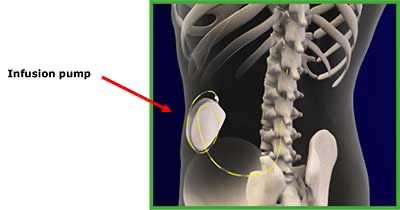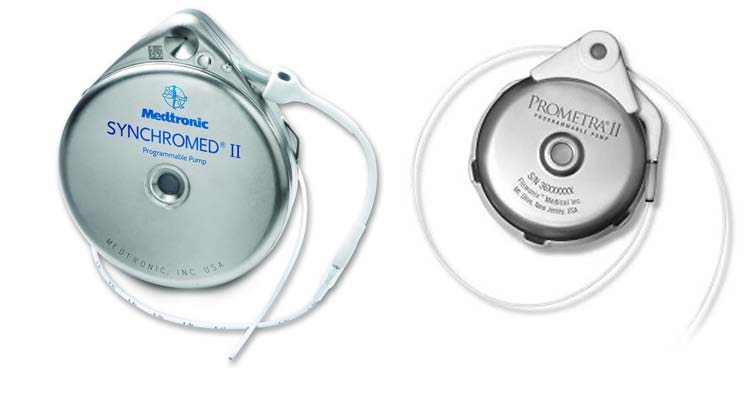What is intrathecal drug delivery (ITDD)?
Intrathecal drug delivery (ITDD) system; a means of delivering medicine very close to the spine for increased effectiveness. This system is often just called a ‘pump’.
Below we will tell you about ITDD systems.
Why might a pump help me?
If you suffer with either persistent cancer pain or muscle spasm from a nerve problem such as MS, spinal injury or brain damage, you might be taking regular medication to relieve your pain or muscle spasms. Over time, you might find that you do not get as much benefit from the medication or that the side effects become unbearable.
Intrathecal drug delivery systems for treating pain and spasms
A pump (see figure 1) delivers medication directly to the (intrathecal) space in your spine. Your spine is made up of a number of bony supports at the front and arches at the back. At the centre of these arches lies the spinal cord. The spinal cord links your brain to the other nerves in your body. The cord floats in spinal fluid in a space called the intrathecal space. This fluid is made in the brain with the aim of cushioning the brain and spinal cord.
Because your pump delivers your medicine very close to your nerves you need lower doses.

A pump is not a cure and may not get rid of all of your pain or spasm. You may still have to take other medicines. However, it can be a better way to control your symptoms than your current drugs. This may mean you can reduce some of your oral medications, return to more of your everyday activities and enjoy better sleep.
There are three parts to an ITDD system:
- The actual pump, a shoe polish tin size battery-powered device that is implanted under the skin of your tummy.
- A thin, flexible tube (catheter) that is connected to the pump and implanted into the fluid filled space in your spine (figure 2) known as the intrathecal space.
- An external programmer, which is used by your doctor or nurse to communicate with and programme your pump during your refill and check-up sessions.
The pump is filled with medicine that is released at a set rate, through the catheter, into your intrathecal space. The pump is filled at the James Cook pain clinic at regular intervals varying from one to six months depending on type of medication and dosage used. The pump is filled using a needle passed through the skin of the abdomen into the pump central port.

How long does the pump last?
The pump is powered by a small internal battery. This usually lasts around seven years, depending on the type of pump. If the battery needs to be changed, you will need to stay in hospital overnight and you will usually need an anaesthetic, either a spinal or general.
What are the risks and possible complications of a pump?
As with any procedure, there are some possible risks and complications. After the pump is installed, there can be side effects from the medicine that is being infused such as nausea and vomiting, itching and problems passing urine. All of these problems are temporary and can be easily treated.
Some side effects of the drug can be potentially serious, such as breathing problems and sedation. In the first few days after the pump has been inserted, the pain team will monitor you closely so that they can treat any side effects quickly.
Complications such as spinal fluid leaks, infection, meningitis, abscesses, bruising and damage to the spinal cord, scar tissue formation, catheter problems or pump malfunction can happen but they are very rare.
In very rare incidents a pump can be refilled with the wrong medication or be programmed to deliver the wrong dose. However, great care is taken by your treatment team to avoid this. If you feel unwell after your refill contact your treatment centre urgently.
How long does the refill take?
This can vary but usually takes about 30 to 45 minutes. You will receive regular appointments for your pump refills from the pain clinic.
You will also receive a booklet that tells you what medication is in your pump and what is the daily dose as well as your next refill date please keep this handy and bring to you on refill appointments.
What do I need to do when I go home after the surgery to implant the pump?
Keep your wounds dry and clean until they have healed. There will be no stiches to remove. Check your wounds daily and look out for any signs of infection such as redness, swelling or discharge. You do not need to remove the dressing to check your wound.
If you suspect you have an infection, you feel unwell or your wounds are red, hot or tender; contact the James Cook pain clinic as soon as possible. Make sure you have the contact details to hand.
How long will it take me to recover?
You will be able to carry out:
- occasional light lifting, three weeks after surgery
- work and driving, four to six weeks after surgery
- lifting heavier items, twelve weeks after surgery
These timescales are only a guide and may vary for different people.
How soon will I start to feel benefit from the ITDD?
You may not notice the benefit of having the ITDD system for several weeks. Your doctor may gradually reduce your pain or spasm medicine over this time.
What if my pain relief does not improve after the ITDD is implanted?
You should let your doctor know. They may change the dose or type of medicine used in the pump.
Can I stop taking other medicines if I have the pump?
You may be able to, but you should follow the advice of your doctor.
Will people be able to see that I have a pump?
People may be able to see the small swelling over the area where the pump is implanted.
Will it affect what clothes I can wear in terms of comfort or possible discomfort? If so, how?
The pump is placed where it is least likely to get in the way of belts and waistbands. Tight clothing may make the pump visible. Someone will discuss this with you before the procedure.
Will I be uncomfortable or at risk wearing a seat belt?
When the specialist team decide where to place the pump, they will consider your comfort. So far no risk of using a seatbelt has been identified.
What happens when my battery runs out?
When the pump battery needs to be replaced you will need to stay in hospital for a short period. This will generally involve an anaesthetic.
Is there an alarm to show there is a problem with the pump?
There are alarms which warn you that the medicine level is low, that the battery is low or that there is a problem with the pump. These alarms vary from device to device. Your doctor and nurse will discuss with you what the alarms sound like and what they mean before you leave hospital with the pump in.
If I hear the alarm, how long do I have before the battery runs out?
Your pump should be refilled before the alarm goes off. If you hear the low-battery alarm, you should arrange to have your battery replaced immediately.
Will electrical equipment interfere with the pump?
Most electrical equipment such as mobile phones, microwaves and household tools will not interfere with the pump. However, some large industrial equipment may have an effect. Because of this, you should avoid getting too close to industrial welding equipment, or equipment that creates a strong electromagnetic field.
Certain treatments can also interfere with your pump, such as short-wave diathermy (heating deep tissue using electricity), radiotherapy, therapeutic ultrasound and bone-growth stimulators. It is therefore important that you let your dentist and physiotherapist know that you have a pump.
Standard x-rays will not interfere with the pump but MRI scans may interfere with the function of some pump models and a check after the scan is advised. Other pump models may need to be emptied before the scan and refilled following the completion of the scan. If you need an MRI scan, tell the radiologist that you have a pump before you go to your appointment.
Can the catheter become dislodged or tear?
The catheter can be dislodged or tear if you move suddenly or vigorously. You should take care if you exercise or move quickly. You can discuss this with your doctor or nurse.
If you have any further questions or concerns you should discuss these with your doctor or nurse.